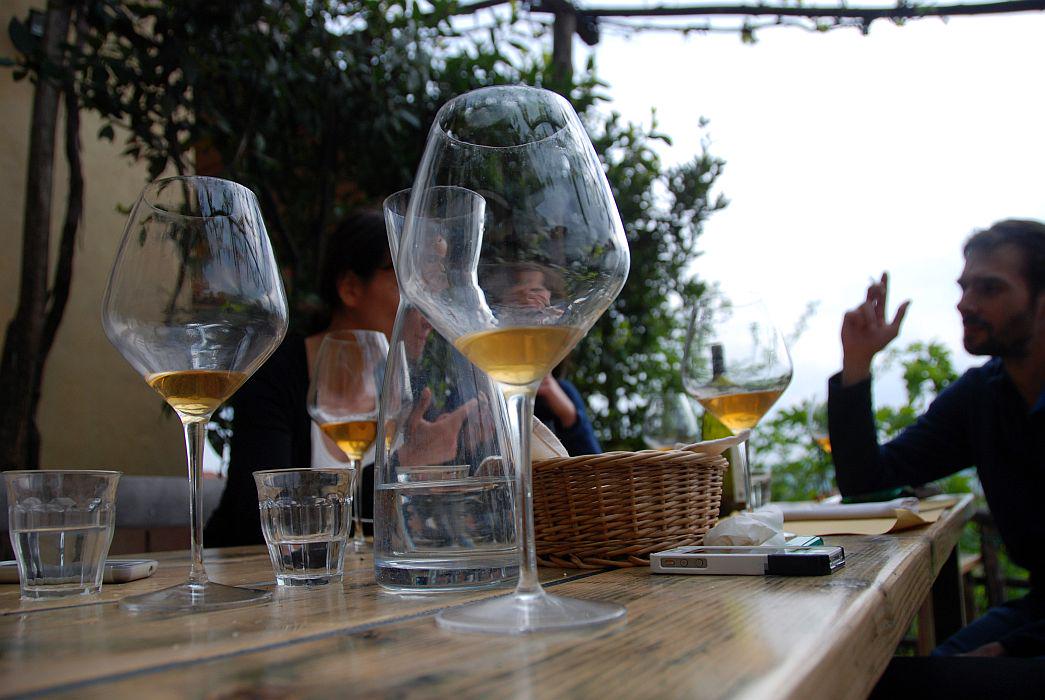
A venerable old lady, the over 400-years-old vine, is growing in Maribor’s Lent, which is the oldest known vine in the world and the pride of the city of Maribor and the whole of Slovenia. The vine serves as the starting point or the destination of many wine routes which are intertwined in the Maribor wine-producing district.
Slovenia is also a land of excellent sparkling wines. Their production according to the classic méthode champenoise started in Radgonske Gorice cellar after 1850. There are more than sixty producers of sparkling wines in Slovenia who follow the classic méthode champenoise and are interesting due to their diverse types of sparkling wines and their quality.
Slovenia is home to genuine native vine varieties, since their cultivation areas are in some sections divided by a state border, certain varieties belong to both sides. Such examples are Rebula and Teran, which are native to both Slovenia and Italy. And also Furmint, which has its roots in Slovenia, Austria, Croatia and Hungary. The native vine variety in the Vipava Valley is Zelen, with good potentials for further development.

Slovenia is a wine country with rich experience in wine production that keeps in step with the world wine production, modern technology and marketing trends. Wine production has a long tradition in Slovenia. In the country whose national anthem is “The Toast” (to all good people), a glass of exquisite wine has special significance. In addition to excellent professional wine-makers and wine cooperatives, there are also many amateur wine-makers. Many vineyard cottages can be found in wine-producing regions, where the family hobby is stored in a barrel or two. These vineyard cottages contribute to the diverse tourist offer of the Dolenjska and Bela Krajina regions.
The proof that wine was being produced in Slovenia many years ago is the Vače situla dating from the 6th century BC, which depicts revelry with wine. The Celts who lived here then produced their own wine. The Romans, known for la dolce vita, also enjoyed the intoxicating drink, and it is not surprising that wine production positively blossomed in the Roman period. The wine culture was somewhat halted with the arrival of the Slavic people from beyond the Carpathian Mountains since they brought different values and customs, but it blossomed again with the spread of Christianity and the arrival of monks. Since we are proud of our wine tradition, we are of course certain that Slovenian wines are among the best in the world.
According to wine criteria, Slovenia belongs to the Old World wine regions with certain French, Italian and German influences in terms of vineyards and production. Its geographic position is perfect for growing vine with the impact from the Adriatic Sea, the Alps and the Pannonian plain. The production of wine is focused on the production of exquisite high-quality wine. Vineyards are usually situated on very steep slopes, enabling the optimum exposure to sunlight; however, this makes work in the vineyards much more demanding and requires more manual labour.
Three wine-producing regions
The Podravje, Posavje and Primorje regions each boast their own particularities and microclimates. Due to their many years of tradition, each of them can offer original native wines with specific local qualities. The Slovenian selection of wines comprises an assortment of red wines in the style of Bordeaux, aromatic wines typical of the Rhine Valley, dry Italian wines, sweet Hungarian wines and also sparkling wines. The development of a diverse range of local wines, including modern and trendy orange and natural wines which have caused quite a stir among the expert wine public has been swift.
Podravje stretches over the north-east part of Slovenia. The region is characterised by typical sediments created by active geological movements, the remains of the Pannonian Sea and thermal and mineral springs. It is thus the soil which particularly characterises the wines of this region. The climate is typically continental, with plenty of sunny days, which sometimes cause drought, while winters are quite cold. The region is known for its prestigious wines and late grape harvest. A temperate climate and special soil are ideal for the production of strong and aromatic white wines, such as White Riesling, Italian Riesling, Sauvignon, Furmint, Pinot Gris, Pinot Blanc, Traminer, Yellow Muscat and Radgona sparkling wine. These are certainly worth tasting.
Posavje is a region situated in the heart of Slovenia, and is known for its mixed wines but most of all for its great little wine – Cviček. With its eight and a half per cent of ethanol, Cviček is hardly a wine according to European criteria, but it nevertheless, or because of it, prides itself on the EU mark of Protected Geographical Indication. Cviček, first documented in books two hundred year ago, is a blend of three grape varieties, which provide it with lightness, its characteristic gentle colour and flavour, including acidity and freshness. Cviček is truly a very drinkable wine that can be found in almost every vineyard cottage in the region. Vineyard cottages are small private wineries, and wine producers who have stubbornly defied natural and social conditions in their small vineyards over the years are typical of this region. In the past, this region was mostly affected by the atrocities of the Second World War and the economic crisis which followed. In addition to Cviček, the region is also known for its quite sweet predicate wines.
Primorska carries such a name (pri-morje means by the sea) although only a small section of the region is actually next to the coast and the majority of vineyards are located in the hinterland but nevertheless enjoy a strong Mediterranean influence. Summers are quite hot here and winters temperate. The entire wine variety of Europe can also be found in this region. Red wines prevail due to the warmth and the sun. Wines of this region have their own particular traits; they are mostly dry, rich in minerals and also contain more pigment than wines in other regions. The Primorska region consist of the Goriška Brda district with the famous Rebula and Pinot Blanc, the Vipava district with excellent white and red wines, and particularly superb Cabernet Sauvignon, the Karst district with Teran, Refosco and Terra Rossa, which is a blend of Teran, Cabernet Sauvignon and Merlot, and the Koper district with Refosco and Malvazija.
Polona Prešeren, SINFO
A venerable old lady, the over 400-years-old vine, is growing in Maribor’s Lent, which is the oldest known vine in the world and the pride of the city of Maribor and the whole of Slovenia. The vine serves as the starting point or the destination of many wine routes which are intertwined in the Maribor wine-producing district.
Slovenia is also a land of excellent sparkling wines. Their production according to the classic méthode champenoise started in Radgonske Gorice cellar after 1850. There are more than sixty producers of sparkling wines in Slovenia who follow the classic méthode champenoise and are interesting due to their diverse types of sparkling wines and their quality.
Slovenia is home to genuine native vine varieties, since their cultivation areas are in some sections divided by a state border, certain varieties belong to both sides. Such examples are Rebula and Teran, which are native to both Slovenia and Italy. And also Furmint, which has its roots in Slovenia, Austria, Croatia and Hungary. The native vine variety in the Vipava Valley is Zelen, with good potentials for further development.

































































